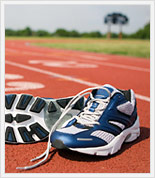 |
Already a member? Secure Login
|

- Ideal Weight Calculator
- Waist-to-Hip Ratio Calculator
- BMI Calculator
- Frame Size Calculator
- Target Heart Rate Calculator

- Good Fast Food
- Recipe Makeovers
- Meal Plans
- Nutrient Facts
- Food Label Claims
- Estimating Serving Sizes



Athletic Shoes: A Buyer's Guide
QUESTION:
My best friend was appalled when she found out that I've been wearing the same tennis shoes for 5 years. I guess it's time to get a new pair! What should I look for in a new pair of exercise shoes?
My best friend was appalled when she found out that I've been wearing the same tennis shoes for 5 years. I guess it's time to get a new pair! What should I look for in a new pair of exercise shoes?
ANSWER:
 Depending on how often you've used them, your shoes have probably lost their shock-absorbing qualities. Depending on the resilience of the cushioning, the type of activity and surface, and your body weight, shoes will typically wear out within 300-500 miles or equivalent time usage. Oftentimes the impact-absorbing features of a shoe will wear out before the outside of the shoe shows any noticeable wear, so don't use looks to gauge internal wear and tear. Exact usage is tedious to track so average out the number of hours or miles that you exercise, and choose a given month to purchase new shoes, say every year on your birthday.
Depending on how often you've used them, your shoes have probably lost their shock-absorbing qualities. Depending on the resilience of the cushioning, the type of activity and surface, and your body weight, shoes will typically wear out within 300-500 miles or equivalent time usage. Oftentimes the impact-absorbing features of a shoe will wear out before the outside of the shoe shows any noticeable wear, so don't use looks to gauge internal wear and tear. Exact usage is tedious to track so average out the number of hours or miles that you exercise, and choose a given month to purchase new shoes, say every year on your birthday.Ideally, shoes should be tailored toward a specific activity. Cross trainers can usually do the job if you perform a wide variety of activities, but if you perform a specific activity 2 or 3 three times a week, then you should buy a sports-specific shoe. Each sport-specific shoe will have properties that are advantageous to that sport. For instance, walking shoes will have extra cushioning in the heel and a design that aids in the roll off the toe. Sports that involve frequent side to side motion will require a shoe with more control features.
Know your feet! Consider the width of your forefoot and heel, the height of your arch or instep, and whether your foot rolls inward or outward during motion. For instance, if you have flat feet that tend to roll inward (known as pronation), purchase shoes that have extra control in this area. Your old shoes can often provide valuable information on how your feet perform in motion. Check the wear patterns of the soles. If you are prone to shin splints, then look for a shoe with extra cushion in the mid sole region. Awareness of your prior problems and foot characteristics can provide insight on the shoe qualities that will most benefit you.
Proper fit is the most important attribute that you should pay attention to when purchasing shoes. Sizes and fit can differ between shoe manufacturers and models, so don't assume anything. Due to foot swelling, buy your shoes late in the day or within an hour of exercising to get the best fit. In addition, make sure that you wear the socks that you will typically be wearing as sock thickness can vary greatly and affect the fit of the shoe. Don't buy shoes that are uncomfortable in hopes of breaking them in! Even on the first fit, they should be comfortable through the arch and ball of foot and hold the heel firmly - no excessive slipping!
I recommend that you purchase shoes from an athletic shoe store that employs knowledgeable sales people. An educated sales person will be able to explain the main features of a shoe and relay how they will benefit a given type of foot in various sports. If you've had prior foot, joint or back problems, a podiatrist can be helpful in guiding you to the proper shoe for your specific problem, and perhaps even recommend orthotics to correct any limb length discrepancies. Have fun shopping!

Our expert, Dr. Sharon E. Griffin, holds a B.S., M.S., and Ph.D. in the areas of exercise science/physiology. She also holds a second M.S. degree in Nutrition and is a licensed nutritionist and an ACSM certified health and fitness instructor.
© 2025 MyFoodDiary.com. All Rights Reserved.